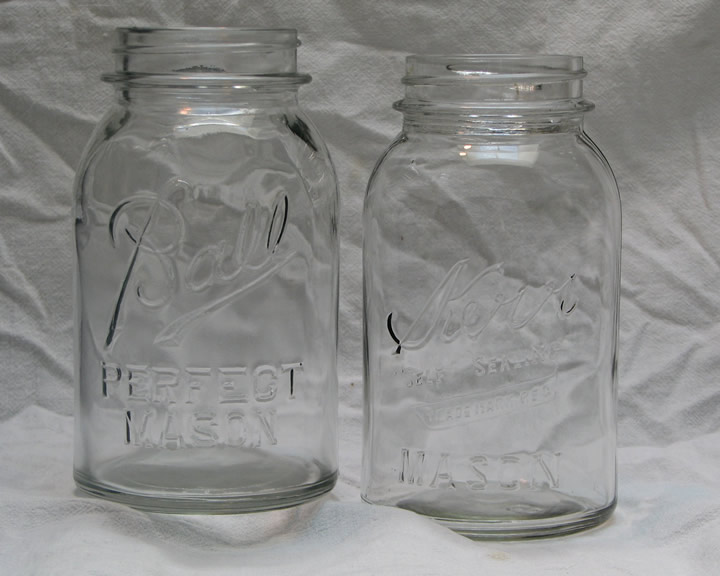
SCP-2103
Thought Preserves

Typical quart-sized Mason Jar.
Special Containment Procedures
SCP-2103 is to be contained in a Safe Object locker when not in use for testing or experimentation. When so stored, SCP-2103 is to be directly contained in a small (no larger than 1m along any dimension) storage case suitable for transporting fragile, glass-like items. This case is to remain open inside the locker and under automated surveillance at all times; specifically observed by an automated process that is able to detect motion and non-motion based visual changes (such as color changes) to the observed area. Any such observed change must be immediately reported to the research team appointed to SCP-2103.
Due to the object's low tolerance for physical stress and heat, tests to determine SCP-2103's composition are halted indefinitely.
Update 10/23/2013: As of Incident 2103-04, no new Lead Researcher or similar position of singular authority is to be appointed to the object's research team. The research team will consist of no fewer than seven qualified research staff, all of which must be consulted when changes to SCP-2103's containment are made or decisions about the testing methods used on the object are determined. In the event that all members of the research team agree unanimously on a course of such action, one team member is to be selected in an immediate, random fashion1. This team member is to adopt a documented dissenting opinion that is to be attached to the log or proposal that is chosen to be put in effect.
If a member of the O5 Council wishes to countermand an action by the research team, a similar procedure, involving at least three members of the Council, must be executed.
Description
SCP-2103 is visually identical to a typical American-made "Mason Jar" glass container. When not displaying anomalous properties, it is able to contain one quart of liquid (assuming the lower hole is blocked) or equivalent volumes of any other material. Unlike typical Mason jars, there is no brand name, logo, manufacturing data, or similar embossment on the glass. There is also a 25mm diameter hole in the center of the jar's bottom, with smooth edges that appear to be part of the original design and not created afterwards. The jar section is made of a material similar in transparency and density to glass, but has shown a much lower resistance to heat and physical stress than glass.
When used to hold physical objects, SCP-2103 displays no unusual properties - items placed into the top of the jar either remain in the jar or exit through the bottom hole if they are of proper size or makeup to do so. However, the holderowning entity2 (see following for details) may store concepts or ideas into the jar through a poorly understood process.
For the purposes of SCP-2103, "ownership" by an entity is loosely defined as said entity having widely acknowledged (or uncontested) legal, moral, or physical responsibility and dominion over the item. The exact parameters of ownership varies somewhat from item to item, suggesting some manner of sentience or programmed decision making process on the part of SCP-2103. For the most part, concepts and ideas that only affect a single individual seem the most easily "owned", while larger concepts that a wide array of individuals understand, are affected by, know about, or make use of fail this criteria.
SCP-2103 is apparently3 capable of storing a single concept or idea (referred to hereafter as "item") at a time. When so stored, knowledge of the item is removed from reality - the previous owner and others cannot recall the item, and depending on the item in question may or may not be able to realize that something is missing at all. SCP-2103 seems to have further limited reality-altering potential, as in many cases the storage of the item causes shifts in reality accordingly as if the item had never been a part of reality.
Due to Incident 2103-04, SCP-2103 has shown an ability to store physical objects under certain circumstances. See Incident Log 2103-04 for further details. Intentional testing to recreate these conditions is pending review but currently forbidden.
SCP-2103 was acquired by the Foundation following a series of Internet postings referring to a "counselor" who promised his clients the ability to eliminate grief and emotionally painful events from their past. After five separate and unrelated accounts of SCP-2103's properties in action (clients discussing a "therapy jar" and an inability to recall certain events they had posted about previously) Foundation observers were sent to contact the counselor under the guise of potential clients. The owner was unwilling to part with the item for various sums of money or other offered exchanges, and proved unaffected by amnesiacs administered by agents on site. After a short confrontation, the subject escaped but SCP-2103 was recovered.
The previous owner of SCP-2103 remains a person of interest to the Foundation. See related Report A-2103 for details.
